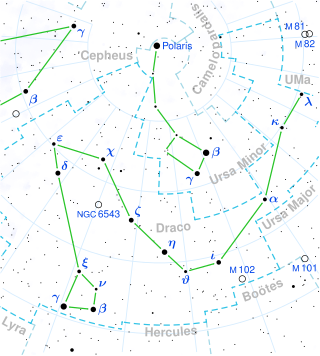Omicron Draconis
| Observation data Epoch J2000 Equinox J2000 | |
|---|---|
| Constellation | Draco |
| Right ascension | 18h 51m 12.09530s[1] |
| Declination | +59° 23′ 18.0627″[1] |
| Apparent magnitude (V) | 4.65[2] |
| Characteristics | |
| Spectral type | G9III[3] |
| U−B color index | +1.19[2] |
| Variable type | RS CVn |
| Astrometry | |
| Radial velocity (Rv) | −19.52[4] km/s |
| Proper motion (μ) | RA: 77.47[1] mas/yr Dec.: 25.37[1] mas/yr |
| Parallax (π) | 9.54 ± 0.21 mas[1] |
| Distance | 106.8[5] pc |
| Details | |
| ο Dra A | |
| Mass | 1.35[5] M☉ |
| Radius | 25.1[5] R☉ |
| Luminosity | 220[5] L☉ |
| Surface gravity (log g) | 1.769[5] cgs |
| Temperature | 4400[6] K |
| Metallicity [Fe/H] | −0.5[3] dex |
| Rotation | 79[5] |
| Age | 3.0[5] Gyr |
| ο Dra B | |
| Mass | 0.99[5] M☉ |
| Radius | 1.0[5] R☉ |
| Luminosity | 1.3[5] L☉ |
| Surface gravity (log g) | 4.43[5] cgs |
| Temperature | 6,000[5] K |
| Orbit[5] | |
| Primary | ο Dra A |
| Companion | ο Dra B |
| Period (P) | 138.444 ± 0.003 days |
| Semi-major axis (a) | 6.51 ± 0.03″ |
| Eccentricity (e) | 0.158 ± 0.003 |
| Inclination (i) | 89.6 ± 0.3° |
| Longitude of the node (Ω) | 22.9 ± 0.2° |
| Periastron epoch (T) | 2454983.0 ± 0.2 |
| Argument of periastron (ω) (secondary) | 293.0 ± 0.6° |
| Semi-amplitude (K1) (primary) | 23.42 ± 0.05 km/s |
| Semi-amplitude (K2) (secondary) | 32.0 ± 0.4 km/s |
| Other designations | |
| Database references | |
| SIMBAD | data |
Omicron Draconis (ο Dra, ο Draconis) is a giant star in the constellation Draco located 322.93 light years from the Earth. It has a radius of 30 solar radii, and a luminosity of 269 suns. Its path in the night sky is circumpolar above the ecliptic, meaning the star never rises or sets when viewed in the night sky from certain positions in the northern hemisphere.
Omicron Draconis can be considered the north pole star of Mercury, as it is the closest star to Mercury's north celestial pole.[citation needed]
This is a single-lined spectroscopic binary system,[6] but the secondary has been detected using interferometry. It is a RS Canum Venaticorum variable system with eclipses. The total amplitude of variation is only about a thousandth of a magnitude.[5] The secondary star is similar to the sun, presumably a main sequence star, while the primary is a giant star 25 times larger than the sun and two hundred times more luminous.
References
- ^ a b c d e Van Leeuwen, F. (2007). "Validation of the new Hipparcos reduction". Astronomy and Astrophysics. 474 (2): 653. arXiv:0708.1752. Bibcode:2007A&A...474..653V. doi:10.1051/0004-6361:20078357.
- ^ a b Hoffleit, Dorrit; Jaschek, Carlos (1991). "The Bright star catalogue". New Haven. Bibcode:1991bsc..book.....H.
- ^ a b Keenan, Philip C.; McNeil, Raymond C. (1989). "The Perkins catalog of revised MK types for the cooler stars". Astrophysical Journal Supplement Series. 71: 245. Bibcode:1989ApJS...71..245K. doi:10.1086/191373.
- ^ Karataş, Y.; Bilir, S.; Eker, Z.; Demircan, O. (2004). "Kinematics of chromospherically active binaries and evidence of an orbital period decrease in binary evolution". Monthly Notices of the Royal Astronomical Society. 349 (3): 1069. arXiv:astro-ph/0404219. Bibcode:2004MNRAS.349.1069K. doi:10.1111/j.1365-2966.2004.07588.x.
{{cite journal}}: CS1 maint: unflagged free DOI (link) - ^ a b c d e f g h i j k l m n Roettenbacher, Rachael M.; Monnier, John D.; Fekel, Francis C.; Henry, Gregory W.; Korhonen, Heidi; Latham, David W.; Muterspaugh, Matthew W.; Williamson, Michael H.; Baron, Fabien; Ten Brummelaar, Theo A.; Che, Xiao; Harmon, Robert O.; Schaefer, Gail H.; Scott, Nicholas J.; Sturmann, Judit; Sturmann, Laszlo; Turner, Nils H. (2015). "Detecting the Companions and Ellipsoidal Variations of RS CVn Primaries. II. O Draconis, a Candidate for Recent Low-mass Companion Ingestion". The Astrophysical Journal. 809 (2): 159. arXiv:1507.03601. Bibcode:2015ApJ...809..159R. doi:10.1088/0004-637X/809/2/159.
- ^ a b Pourbaix, D.; Boffin, H. M. J. (February 2003), "Reprocessing the Hipparcos Intermediate Astrometric Data of spectroscopic binaries. II. Systems with a giant component", Astronomy and Astrophysics, 398 (3): 1163–1177, arXiv:astro-ph/0211483, Bibcode:2003A&A...398.1163P, doi:10.1051/0004-6361:20021736
External links
- 2004. Starry Night Pro, Version 5.8.4. Imaginova. ISBN 978-0-07-333666-4. www.starrynight.com

